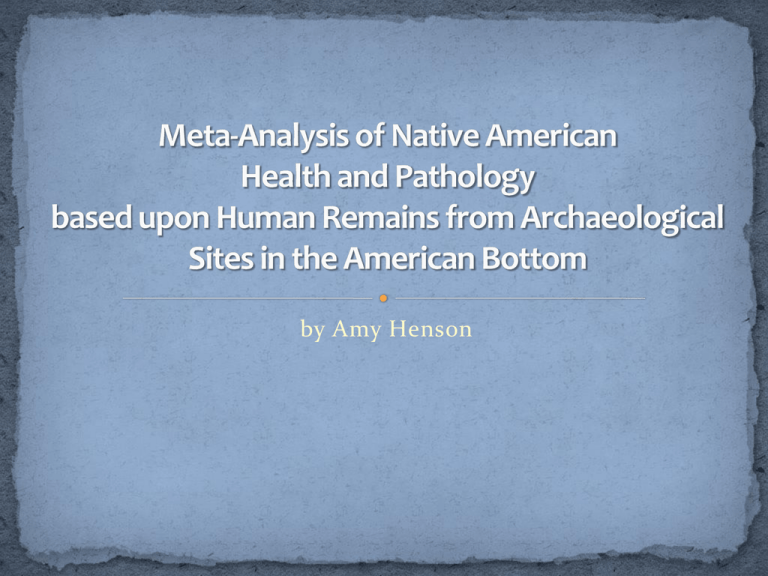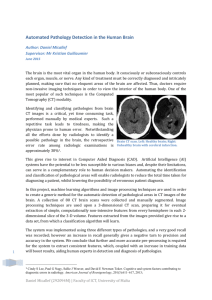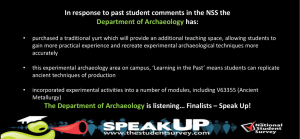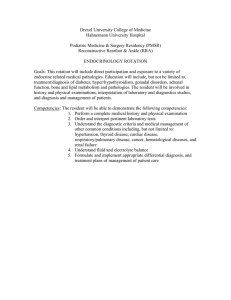by Amy Henson
advertisement

by Amy Henson 13 Advent of Agriculture Resulting changes: Subsistence Settlement Patterning Social Stratification Nutrition and Health Use of Human Remains 14 Gather and evaluate archaeological site reports Construct database of sites, human remains, demographic data and pathologies Carry out analyses on database to: Determine patterns and prevalence of pathologies Evaluate differences in pathological patterns by age and sex Evaluate differences in pathological patterns by cultural period 16 Modoc Rock Shelter Dohack Site Range Site BBB Motor Site Florence Street Site Halliday Site Mound 72, Cahokia Radic site Turner Site Julien Site Hill Prairie Mounds East St. Louis Stone Quarry 15 17 Degenerative pathologies most common Skeletal Pathologies: Infection-related more common Dental Pathologies: Nutrition-related more common 19 18 Skeletal Pathologies Degenerative most common, except neonates and infants Nutrition-related most common in neonates and infants Dental Pathologies Nutrition-related most common, overall Unusual findings in the Archaic Evidence of better health? Limitations Small Sample Sizes Lack of newer methods Incomplete Site Reports Contribution Preliminary study Template Suggestions Standard for Site Reports Further Research Dr. Rehg, for her infinite patience, encouragement, and advice throughout this study and the past four years. Mike and Lisa Henson, for their patience, assistance, and encouragement through the long hours of research and data entry. 1. Ambrose SH, Buikstra J, Kreuger HW. 2003. Status and gender difference in diet at Mound 72, Cahokia, revealed by isotopic analysis of bone. Journal of Anthropological Archaeology 22: 217-226. 2. Armelagos GJ. 1990. “Health and Disease in Prehistoric Populations in Transition.” In: Swedlund AC, Armelagos GJ, editors. Disease in Populations in Transition. p 127-144. 3. Armelagos GJ, Brown PJ, Turner B. 2005. Evolutionary, historical and political economic perspectives on health and disease. Social Science and Medicine 61: 755-765. 4. Cook, DC. 1984. “Subsistence and Health in the Lower Illinois Valley: Osteological Evidence.” In: Cohen MN, Armelagos GJ, editors. Paleopathology at the Origins of Culture. p 235-269. 5. Hedman KM. 2006. Late Cahokian subsistence and health: stable isotope and dental evidence. Southeastern Archaeology 25(2): 258-274. 6. Milner GR. 1992. “Morbidity, Mortality, and the Adaptive Success of an Oneota Population from West-Central Illinois.” In: Woods W.I., editor. Late Prehistoric Agriculture: Observations from the Midwest. p 136-166. 7. Goodman AH, Martin DL. 2002. “Reconstructing Health Profiles from Skeletal Remains.” In: Steckel RH, Rose JC, editors. p 11-60. 8. Yerkes RW. 2005. Bone Chemistry, Body Parts, and Growth Marks: Evaluating Ohio Hopewell and Cahokia Mississippian Seasonality, Subsistence, Ritual, and Feasting. American Antiquity 70(2): 241-265. 9. Danforth ME. 1999. Nutrition and Politics in Prehistory. Annual Review of Anthropology 28: 1-25. 10. Kelly JE. 1992. “The Impact of Maize on the Development of Nucleated Settlements: An American Bottom Example.” In: Woods W.I., editor. Late Prehistoric Agriculture: Observations from the Midwest. p 167-197. 11. Ramenofsky AF, Wilbur AK, Stone AC. 2003. Native American disease history: past, present and future directions. World Archaeology 35(2): 241-257. 12. Lewis M, Roberts C. 1997. Growing Pains: the Interpretation of Stress Indicators. International Journal of Osteoarchaeology 7: 581-586. 13. “Mayan Maize.” Photograph. From Mayan Riviera: Try Mayan Food in the Riviera Maya. http://www.rivieramaya.info/news/uploaded_images/mayanmaize-790916-790993.bmp . 14. “Bioarch.Skel.” Photograph. From Bioarchaeology. http://www.dur.ac.uk/archaeology/research/groupings/bioarchaeology. 15. Hedman K, Hargrave EA. 1999. Hill Prairie Mounds: The Osteology of a Late Middle Mississippian Mortuary Population. Transportation Archaeological Research Reports. no 6. 16. “A Culture Sequence and Chronology of Illinois.” Photograph. From Illinois Archaeological Survey: Resources for Educators. http://virtual.parkland.edu/IAS/resources_for_educators/timeline8x10c.jpg. 17. “Marginal lipping, representing osteoarthritis.” Clark Spencer Larsen. Photograph. From Post-Pleistocene Human Evolution: Bioarchaeology of the Agricultural Transition. http://cast.uark.edu/local/icaes/conferences/wburg/posters/cslarsen/larsen.html.. 18. “Treponematosis.” Mike Henderson. Photograph. From The working life of Museum of London. http://www.mymuseumoflondon.org.uk/blogs/blog/category/centre-for-human-bioarchaeology/page/2/. 19. “Hypoplasia in a juvenile.” Clark Spencer Larsen. 1998. From Post-Pleistocene Human Evolution: Bioarchaeology of the Agricultural Transition. http://cast.uark.edu/local/icaes/conferences/wburg/posters/cslarsen/larsen.html.. 20. “Archaic Period.” Greg Harlin. From Archaeology and the Native Peoples of Tennessee. http://mcclungmuseum.utk.edu/permanent/native/archaic.shtml.




